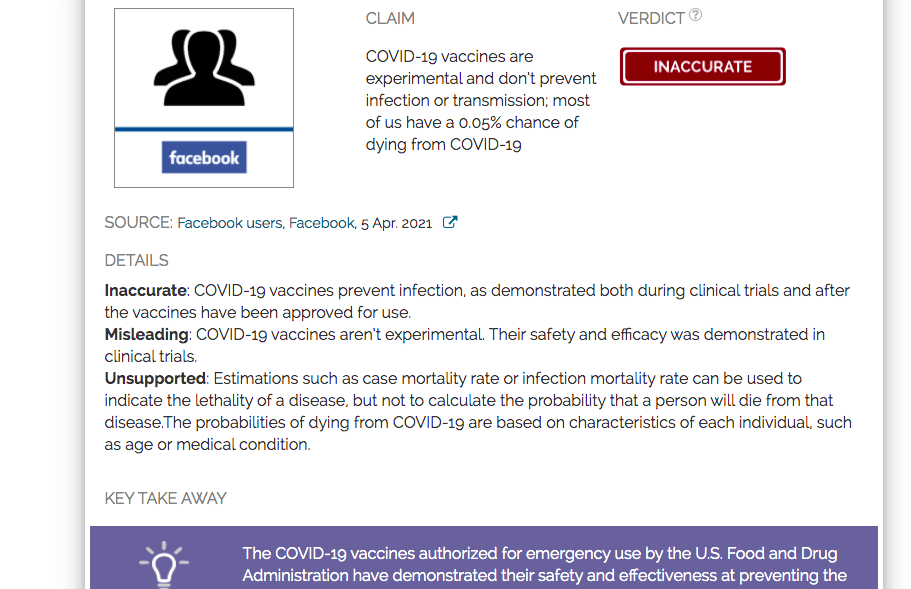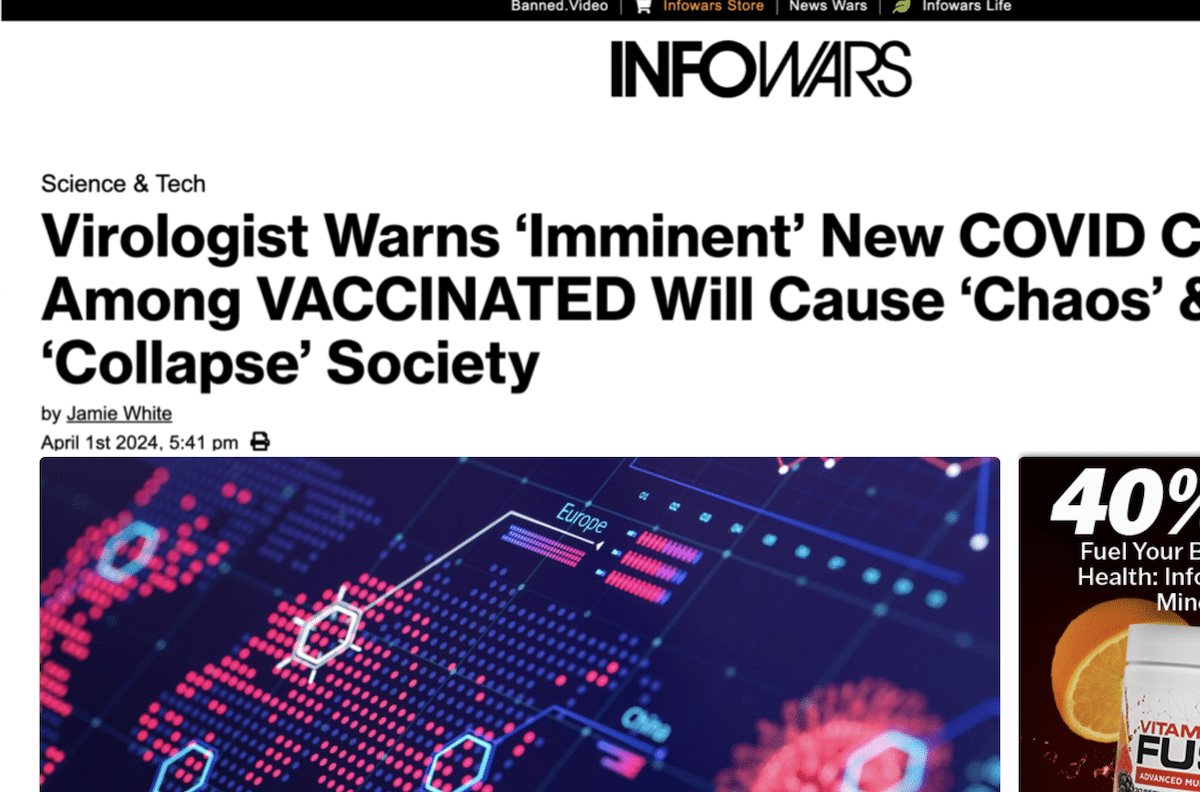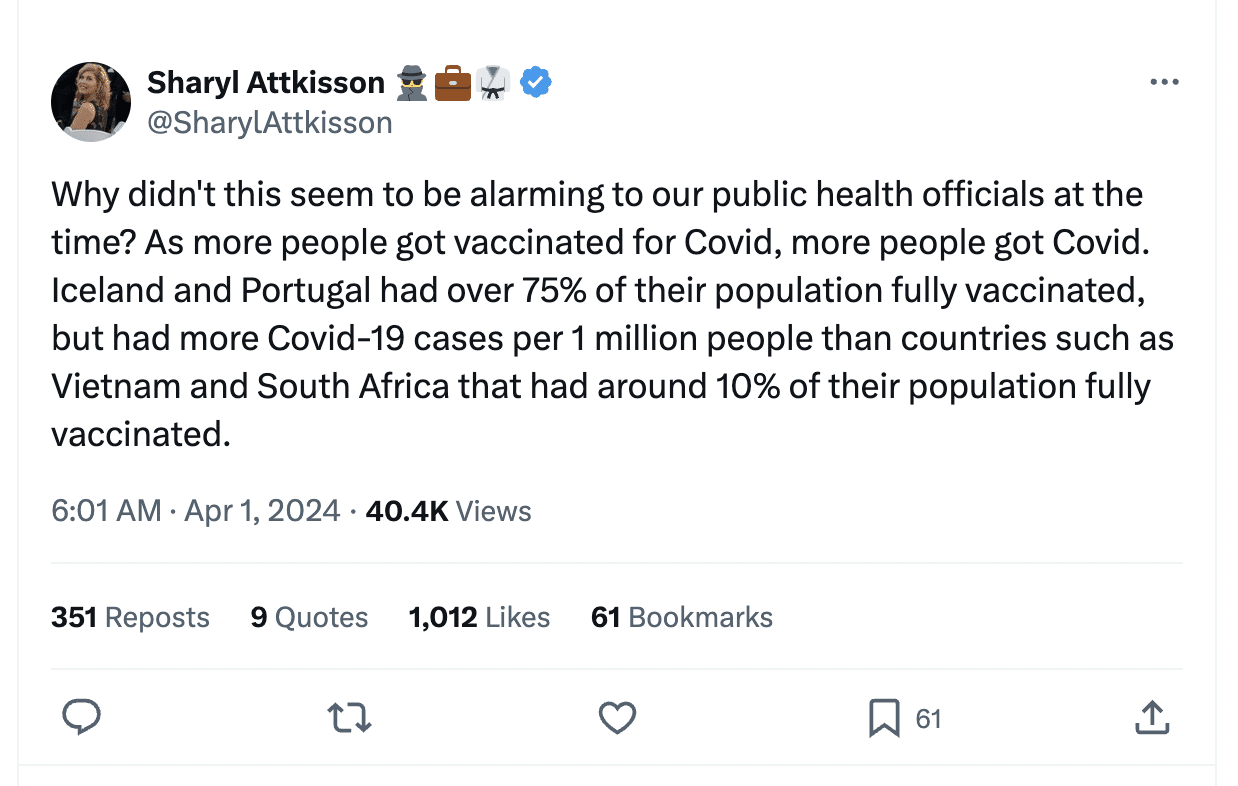- Health
Clinical trials and post-trial monitoring show that COVID-19 vaccines reduce the spread and occurrence of the disease
Key takeaway
The COVID-19 vaccines authorized for emergency use by the U.S. Food and Drug Administration have demonstrated their safety and effectiveness at preventing the disease. Estimations for the lethality of a disease cannot be extrapolated to individuals, since the probability of an individual dying from a disease depends on their own characteristics, such as age and preexisting conditions.
Reviewed content

Verdict:
Claim:
COVID-19 vaccines are experimental and don’t prevent infection or transmission; most of us have a 0.05% chance of dying from COVID-19
Verdict detail
Inaccurate: COVID-19 vaccines prevent infection, as demonstrated both during clinical trials and after the vaccines have been approved for use.
Misleading: COVID-19 vaccines aren’t experimental. Their safety and efficacy were demonstrated in clinical trials.
Unsupported: Estimations such as case mortality rate or infection mortality rate can be used to indicate the lethality of a disease, but not to calculate the probability that a person will die from that disease.The probabilities of dying from COVID-19 are based on characteristics of each individual, such as age or medical condition.
Full Claim
"We’re about to be forced to have a digital ID, proving we’ve had an experimental vaccine, which doesn’t prevent infection or transmission of a virus that most of us have a 0.05% chance of dying from, so we can live [a] ‘normal life’."
Review
Since several COVID-19 vaccines were authorized for use, numerous posts have circulated on social media claiming that these vaccines are experimental or that they don’t prevent the disease or its transmission. Some posts, like this one that went viral reaching 3,500 interactions on Facebook in two days, also downplayed the likelihood of dying from the virus. This review explains why these statements are incorrect.
Claim 1 (Incorrect): COVID-19 vaccines don’t prevent infection or transmission
All three COVID-19 vaccines that have been authorized for emergency use in the U.S. have shown efficacy in preventing the disease based on data from clinical trials. The follow-up of the vaccinated population also showed a high efficacy of mRNA vaccines. These vaccines have also been shown to be at least partially effective against new variants of SARS-CoV-2.
A recent real-life study carried out by the U.S. Centers for Disease Control and Prevention (CDC) has shown that the Pfizer-BioNTech and Moderna vaccines reduced the risk of infection by 80% after one injection, and by up to 90% after the second dose of vaccine[1].
Scientists are still working to establish whether the COVID-19 vaccines can also prevent transmission. There is some evidence suggesting that vaccinated people may be less likely to transmit the virus.
Claim 2 (Misleading): COVID-19 vaccines are experimental
The Facebook post claimed that COVID-19 vaccines are experimental, implying that their safety and effectiveness haven’t been determined, which has been previously debunked in an earlier Health Feedback review. As of 7 April 2021, three COVID-19 vaccines have been authorized for emergency use in the U.S. Pfizer-BioNTech’s vaccine was licensed by the U.S. Food and Drug Administration (FDA) on 11 December 2020, Moderna’s on 18 December 2020 and Johnson & Johnson’s on 27 February 2021.
The safety and efficacy of these vaccines have been demonstrated through Phase I, Phase II and Phase III clinical trials. The FDA made the biological and clinical data for the Pfizer-BioNTech, Moderna, and Johnson & Johnson vaccines publicly available. Clinical trials showed a vaccine efficacy of 95%, 94.5% and 66.9%, respectively, which refers to the reduction in disease incidence in a vaccinated group compared to an unvaccinated group.
Clinical trials also demonstrated the safety of these vaccines. Most of the side effects observed are mild and transient, related to the body’s reaction to vaccination. They include redness and pain at the injection site, fever or headache. A side effect associated with mRNA vaccines are allergic reactions[2], which in rare cases may trigger anaphylaxis. However, anaphylaxis can be effectively treated in the medical setting.
On the other hand, the AstraZeneca COVID-19 vaccine, which has not yet been approved for use in the U.S., is suspected of causing certain health problems. Specifically, the vaccine has been linked to blood clots that could be fatal in extremely rare cases, with 18 reported cases out of a total of 25 million doses administered in Europe. However, investigations are still underway and a causal relationship between the vaccine and the occurrence of blood clots has not yet been established, according to a statement issued by the World Health Organization Global Advisory Committee on 7 April 2021.
In addition, once a vaccine is approved or licensed, it enters Phase IV trials[3]. In this phase, the population that received the vaccine is monitored and researchers determine whether the vaccine provides the same benefits in the real world as it did in initial clinical trials. Continued follow-up after vaccine approval is a standard procedure that allows to test its efficacy in a much larger population, with varied organ system function and concomitant drugs.
Claim 3 (Unsupported): Most people have a 0.05% chance of dying from COVID-19
One marker of the threat posed by a disease is its fatality rate. There are several ways to measure fatality rate. For example, researchers can measure the case fatality rate, which is the proportion of deaths among confirmed cases of the disease. As of 7 April 2021, the COVID-19 case fatality rate is 1.8% in the U.S.
However, the case fatality rate underestimates the number of people actually infected, since the number of detected COVID-19 cases is lower than the actual number of infections, owing to issues such as insufficient testing and mild or absent disease symptoms[4]. For this reason, seroprevalence studies are carried out to infer the real number of people infected. This allows researchers to estimate the infection fatality rate, which is the proportion of deaths among all infections, both confirmed and undetected.
The post stated that the probability of dying from COVID-19 for most people is 0.05%, but it is not clear where this figure comes from. In a seroprevalence study[5], a median of 0.05% infection mortality rate was obtained among different sampled locations, for people under 70 years old. However, the same study also stated that “the infection fatality rate is not a fixed physical constant and it can vary substantially across locations, depending on the population structure, the case-mix of infected and deceased individuals and other, local factors”.
However, neither the case fatality rate nor the infection fatality rate indicate a person’s likelihood of dying from the disease, as both rates don’t account for individual variations in a person’s risk of infection or death. For instance, people who belong to a group that is more vulnerable to the virus, like the elderly or people with certain medical conditions, will have a higher chance of dying from COVID-19 than others.
REFERENCES
- 1 – Thompson et al. (2021). Interim Estimates of Vaccine Effectiveness of BNT162b2 and mRNA-1273 COVID-19 Vaccines in Preventing SARS-CoV-2 Infection Among Health Care Personnel, First Responders, and Other Essential and Frontline Workers — Eight U.S. Locations, December 2020–March 2021. Morbidity and Mortality Weekly Report.
- 2 – Shimabukuro et al. (2021). Allergic Reactions Including Anaphylaxis After Receipt of the First Dose of Pfizer-BioNTech COVID-19 Vaccine — United States, December 14–23, 2020. Morbidity and Mortality Weekly Report.
- 3 – Suvarna (2010). Phase IV of Drug Development. Perspectives in Clinical Research.
- 4 – Li et al. (2020) Substantial undocumented infection facilitates the rapid dissemination of novel coronavirus (SARS-CoV-2). Science.
- 5 – Ioannidis (2020). Infection fatality rate of COVID-19 inferred from seroprevalence data. Bulletin of the World Health Organization.



